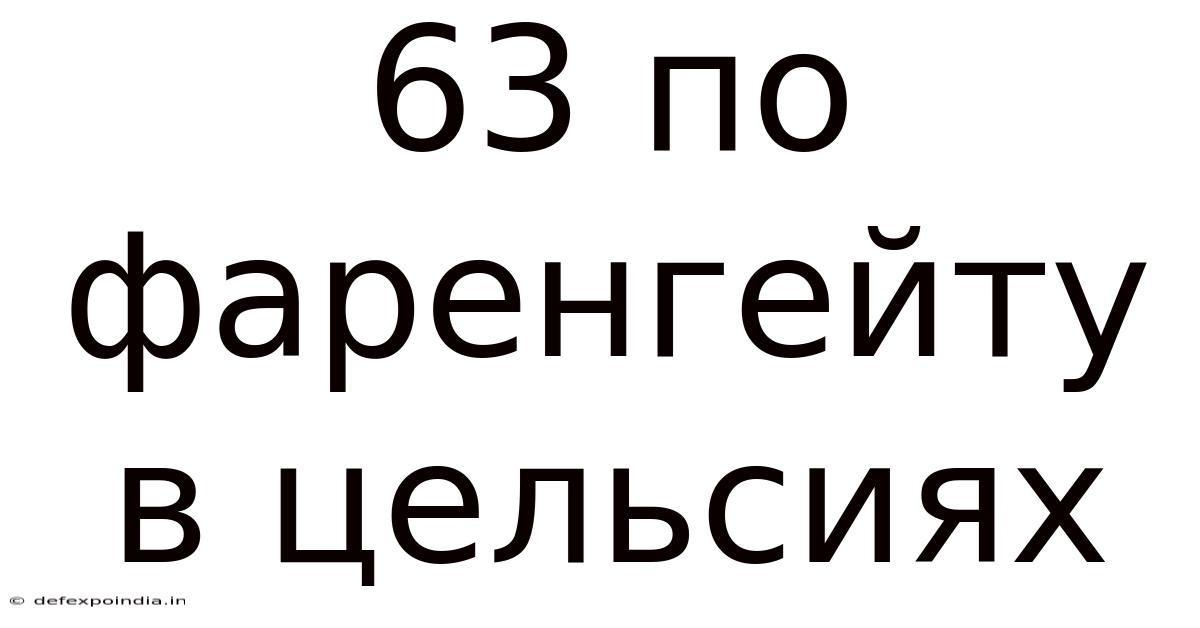63 По Фаренгейту В Цельсиях
defexpoindia
Sep 21, 2025 · 4 min read

Table of Contents
63 Degrees Fahrenheit in Celsius: A Comprehensive Guide to Temperature Conversions
Converting between Fahrenheit (°F) and Celsius (°C) is a common task, particularly for those working with international data or engaging with different measurement systems. This article will thoroughly explain how to convert 63°F to Celsius, provide the formula and its background, discuss the history of both scales, and offer practical applications and frequently asked questions about temperature conversions. Understanding these conversions is crucial for various fields, from cooking and meteorology to engineering and medicine. Let's dive in!
Understanding the Fahrenheit and Celsius Scales
Before jumping into the conversion, let's briefly understand the two temperature scales involved.
-
Fahrenheit (°F): Developed by Daniel Gabriel Fahrenheit in the early 18th century, this scale initially set 0°F as the freezing point of a brine solution (a mixture of water, ice, and ammonium chloride) and 96°F as the average human body temperature. Later adjustments placed the freezing point of water at 32°F and the boiling point at 212°F at standard atmospheric pressure. Fahrenheit remains predominantly used in the United States.
-
Celsius (°C): Also known as the centigrade scale, Celsius was devised by Anders Celsius in the 18th century. This scale defines 0°C as the freezing point of water and 100°C as its boiling point at standard atmospheric pressure. It's the most widely used temperature scale globally and is the standard unit of temperature in the International System of Units (SI).
Converting 63°F to Celsius: The Formula and Calculation
The conversion between Fahrenheit and Celsius is a linear transformation. The formula to convert Fahrenheit to Celsius is:
°C = (°F - 32) × 5/9
Let's apply this to 63°F:
- Subtract 32: 63°F - 32°F = 31°F
- Multiply by 5/9: 31°F × 5/9 ≈ 17.22°C
Therefore, 63°F is approximately equal to 17.22°C.
The Science Behind the Conversion Formula
The formula's 5/9 factor reflects the different scales between the freezing and boiling points of water. There are 180 degrees between the freezing and boiling points of water on the Fahrenheit scale (212°F - 32°F = 180°F) and 100 degrees on the Celsius scale (100°C - 0°C = 100°C). The ratio 180/100 simplifies to 9/5, and its reciprocal, 5/9, is used in the conversion formula. Subtracting 32 accounts for the difference in the freezing point of water between the two scales.
Practical Applications of Temperature Conversions
The ability to convert between Fahrenheit and Celsius is essential in numerous fields:
- International Collaboration: Scientists, engineers, and researchers often collaborate across countries, requiring them to seamlessly translate temperature readings.
- Meteorology: Weather reports often provide temperatures in both Fahrenheit and Celsius, facilitating understanding for a global audience.
- Cooking and Baking: Many recipes specify temperatures in either Fahrenheit or Celsius; accurate conversion ensures the proper outcome.
- Medicine: Body temperature and medication storage requirements often involve both scales.
- Industrial Processes: Many industrial processes maintain specific temperature ranges that necessitate accurate conversion.
- HVAC Systems: Heating, ventilation, and air conditioning systems often operate within temperature ranges specified in both scales.
Beyond the Conversion: Understanding Temperature and its Effects
Understanding temperature goes beyond simple conversions. Temperature directly impacts various physical properties of matter, including:
- State of Matter: Temperature changes can cause substances to transition between solid, liquid, and gaseous states (e.g., ice melting, water boiling).
- Density: The density of most substances changes with temperature, typically decreasing with increasing temperature.
- Chemical Reactions: Temperature significantly influences the rate of chemical reactions, with higher temperatures generally increasing reaction rates.
- Thermal Expansion: Most materials expand when heated and contract when cooled. This principle is crucial in engineering design to prevent thermal stress.
Frequently Asked Questions (FAQs)
Q1: Is there a formula to convert Celsius to Fahrenheit?
Yes, the reverse conversion is: °F = (°C × 9/5) + 32
Q2: Why are there two different temperature scales?
The Fahrenheit and Celsius scales evolved independently. Fahrenheit was developed earlier and used different reference points. Celsius later emerged as a more systematic and widely adopted system.
Q3: What is the absolute zero point in Celsius?
Absolute zero, the theoretical lowest possible temperature, is -273.15°C. This corresponds to 0 Kelvin (K) on the absolute temperature scale.
Q4: Are there other temperature scales besides Fahrenheit and Celsius?
Yes. Besides Kelvin, there's also the Rankine scale, which is an absolute temperature scale based on the Fahrenheit degree.
Q5: How accurate is the conversion 63°F to 17.22°C?
The conversion is accurate to two decimal places. For most practical purposes, this level of accuracy is sufficient. However, more precise calculations may be needed for scientific applications.
Conclusion: Mastering Temperature Conversions for a Globalized World
The ability to convert between Fahrenheit and Celsius is a valuable skill in our increasingly interconnected world. Understanding the formula, its derivation, and the practical applications discussed here ensures that you can confidently navigate different temperature systems. While 63°F translates to approximately 17.22°C, the real value of understanding these conversions lies in the broader context of how temperature affects our world and the many fields where accurate measurement is paramount. Whether you're a student, a professional, or simply curious about the world around you, mastering these conversions opens doors to a deeper understanding of physics, engineering, and the environment.
Latest Posts
Latest Posts
-
Base 9 To Base 10
Sep 21, 2025
-
Mm 3 To In 3
Sep 21, 2025
-
How Much Is 500 Ft
Sep 21, 2025
-
How Tall Is 161 Cm
Sep 21, 2025
-
1 Metre 85 In Feet
Sep 21, 2025
Related Post
Thank you for visiting our website which covers about 63 По Фаренгейту В Цельсиях . We hope the information provided has been useful to you. Feel free to contact us if you have any questions or need further assistance. See you next time and don't miss to bookmark.